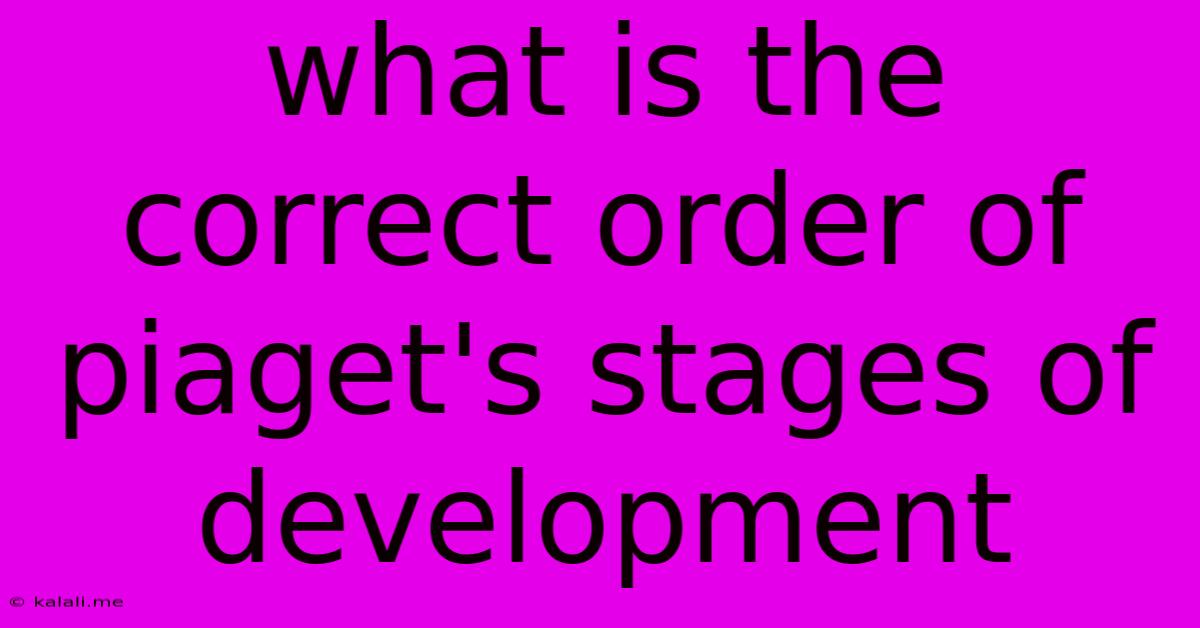What Is The Correct Order Of Piaget's Stages Of Development
Kalali
Jun 15, 2025 · 3 min read

Table of Contents
What is the Correct Order of Piaget's Stages of Development?
Jean Piaget's theory of cognitive development is a cornerstone of developmental psychology. Understanding the correct order of his four stages is crucial for educators, parents, and anyone interested in child development. This article outlines Piaget's stages, their key characteristics, and the typical age ranges associated with each. Understanding this developmental sequence can help you better support children's learning and growth.
Piaget's theory proposes that children move through four distinct stages of cognitive development, each characterized by unique ways of thinking and understanding the world. These stages are sequential and build upon each other, meaning children must master the skills and concepts of one stage before progressing to the next. Let's explore each stage in the correct order:
1. Sensorimotor Stage (Birth to 2 years)
This initial stage is all about sensory experiences and motor actions. Infants learn about the world through their senses – seeing, hearing, touching, tasting, and smelling – and their actions – sucking, grasping, reaching. Key developments during this stage include:
- Object permanence: The understanding that objects continue to exist even when they are out of sight. Before developing object permanence, infants act as if an object ceases to exist once it's hidden.
- Goal-directed behavior: The ability to plan and perform actions to achieve a specific goal, such as reaching for a toy.
- Symbolic thought: The beginning of using symbols, like words or gestures, to represent objects or ideas.
2. Preoperational Stage (2 to 7 years)
The preoperational stage marks the emergence of symbolic thinking, allowing children to represent objects and events mentally. However, their thinking remains egocentric and lacks logical reasoning. Characteristics of this stage include:
- Egocentrism: Difficulty seeing things from another person's perspective. Children assume everyone sees and thinks the same way they do.
- Animism: Attributing life-like qualities to inanimate objects. For example, believing the sun is happy or a toy is sad.
- Centration: Focusing on only one aspect of a situation at a time, neglecting other relevant features.
- Lack of conservation: Not understanding that quantity remains the same even if appearance changes (e.g., pouring liquid from a tall, thin glass into a short, wide glass).
3. Concrete Operational Stage (7 to 11 years)
In this stage, children develop logical reasoning but still struggle with abstract concepts. Their thinking is grounded in concrete experiences and objects. Key developments include:
- Conservation: Understanding that quantity remains the same despite changes in appearance.
- Classification: The ability to group objects based on shared characteristics.
- Seriation: The ability to arrange objects in order based on a specific characteristic (e.g., size, weight).
- Transitive inference: The ability to understand relationships between objects indirectly (e.g., if A is taller than B, and B is taller than C, then A is taller than C).
4. Formal Operational Stage (11 years and beyond)
This final stage is characterized by the ability to think abstractly, hypothetically, and deductively. Adolescents and adults in this stage can engage in complex reasoning and problem-solving. Characteristics include:
- Abstract thinking: The ability to think about concepts that are not tied to concrete objects or experiences.
- Hypothetical reasoning: The ability to consider possibilities and test hypotheses.
- Deductive reasoning: The ability to draw logical conclusions from premises.
- Metacognition: The ability to think about one's own thinking processes.
It's important to remember that these are age ranges, and individual development can vary. Some children may reach certain milestones earlier or later than others. Piaget's theory provides a valuable framework for understanding how children's thinking develops, but it's not a rigid prescription. Each child's journey through these stages is unique and influenced by a multitude of factors.
Latest Posts
Latest Posts
-
Differentiate Between Short Run And Long Run
Jun 15, 2025
-
What Is The Difference Between An Entrepreneur And Entrepreneurship
Jun 15, 2025
-
Which Of The Following Is A Nonrenewable Energy
Jun 15, 2025
-
Is An Alloy A Heterogeneous Mixture
Jun 15, 2025
-
Which Is The Longest Phase Of Mitosis
Jun 15, 2025
Related Post
Thank you for visiting our website which covers about What Is The Correct Order Of Piaget's Stages Of Development . We hope the information provided has been useful to you. Feel free to contact us if you have any questions or need further assistance. See you next time and don't miss to bookmark.